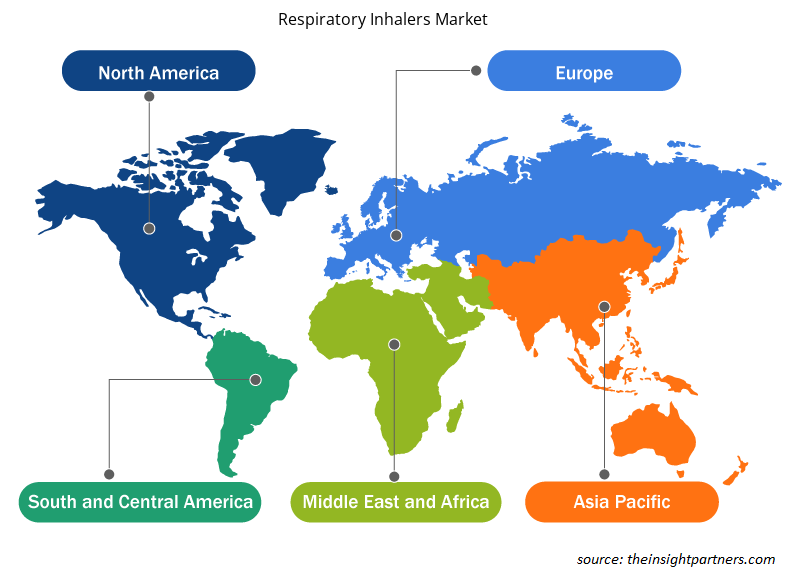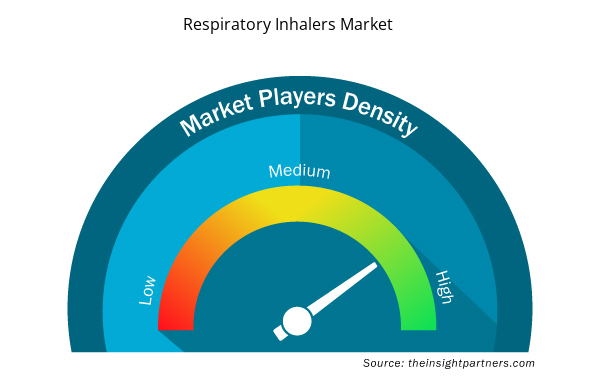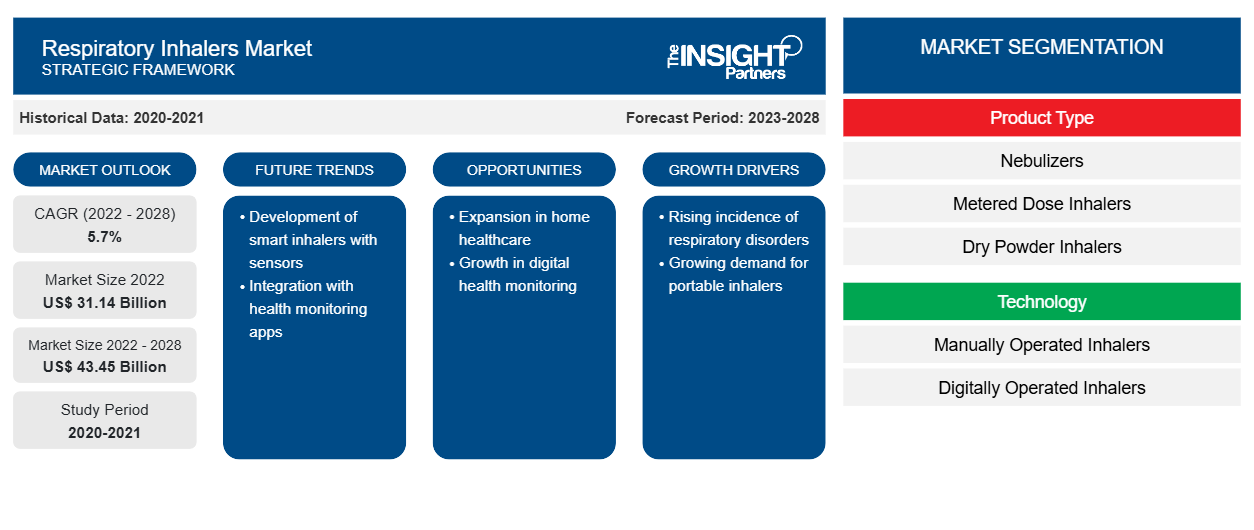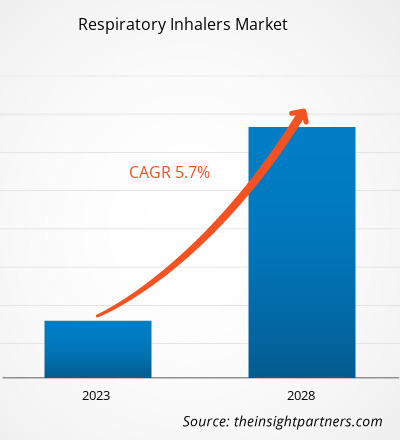Se espera que el mercado de inhaladores respiratorios crezca de US$ 31.144,56 millones en 2022 a US$ 43.446,19 millones en 2028; se estima que registrará una CAGR del 5,7% de 2022 a 2028.
Los inhaladores respiratorios se utilizan para inhalar medicamentos que son una parte esencial del tratamiento de enfermedades pulmonares crónicas. Se utilizan tanto para prevenir como para tratar las exacerbaciones de estas enfermedades crónicas. Ofrecen la ventaja de evitar la exposición sistémica a los medicamentos y, al mismo tiempo, garantizar que los medicamentos lleguen directamente a los pulmones. Numerosos productos administran medicamentos directamente a las vías respiratorias, como los inhaladores de polvo seco, los inhaladores de dosis medida (IDM), los nebulizadores y los inhaladores de niebla suave . Se espera que el mercado de inhaladores respiratorios crezca debido a la creciente prevalencia de enfermedades respiratorias como el asma, la enfermedad pulmonar obstructiva crónica (EPOC), la fibrosis quística, el síndrome de superposición asma-EPOC y otras.
Personalice este informe según sus necesidades
Obtendrá personalización en cualquier informe, sin cargo, incluidas partes de este informe o análisis a nivel de país, paquete de datos de Excel, así como también grandes ofertas y descuentos para empresas emergentes y universidades.
- Obtenga las principales tendencias clave del mercado de este informe.Esta muestra GRATUITA incluirá análisis de datos, desde tendencias del mercado hasta estimaciones y pronósticos.
Perspectivas del mercado de inhaladores respiratorios
La creciente adopción de inhaladores genéricos impulsa el crecimiento del mercado de inhaladores respiratorios
Los medicamentos inhalados que implican una amplia gama de dispositivos de inhalación son la base del tratamiento farmacológico del asma y la EPOC. Los pacientes que sufren asma y EPOC a menudo necesitan uno o más inhaladores diariamente para mantener sus vías respiratorias sanas. Por lo tanto, los profesionales de la salud están preocupados por cambiar de medicación, ya que puede afectar negativamente al control de la enfermedad debido a la baja adherencia y el mal uso de los tipos de dispositivos de administración de aerosoles. Con la creciente presión sobre los presupuestos de atención médica y la expiración simultánea de las patentes de los tratamientos de inhalación establecidos, se están fabricando y suministrando varios productos de reemplazo genéricos en todo el mundo. Varios inhalantes que se utilizan para tratar el asma incluyen formulaciones genéricas, como albuterol, levalbuterol, ipratropio, budesonida y fluticasona/salmeterol. Los inhaladores genéricos son bioequivalentes a las versiones de marca y tienen el mismo efecto en el cuerpo. La cantidad de inhaladores genéricos para el asma continúa aumentando a medida que expiran las patentes. El 3 de marzo de 2020, la Administración de Alimentos y Medicamentos (FDA) autorizó los inhaladores genéricos para el asma y el polvo de corticosteroides inhalados genéricos. En abril de 2020, la FDA aprobó un inhalador genérico, basado en sulfato de albuterol, para atender las necesidades de los pacientes de COVID-19 que tienen dificultades respiratorias. A medida que más medicamentos genéricos ingresan al mercado, se espera una mayor competencia, lo que, a su vez, conduce a una reducción de los costos de los medicamentos. Las reducciones de costos también pueden resultar del lanzamiento de un "medicamento genérico aprobado". Por lo tanto, la creciente adopción de inhaladores genéricos y medicamentos para el asma está mejorando la adherencia a la medicación, lo que impulsa el mercado de inhaladores respiratorios.
Información basada en el tipo de producto
Según el tipo de producto, el mercado de inhaladores respiratorios se segmenta en nebulizadores , inhaladores de dosis medidas e inhaladores de polvo seco. El segmento de inhaladores de polvo seco se bifurca a su vez en inhaladores de polvo seco multidosis e inhaladores de polvo seco monodosis. El segmento de inhaladores de dosis medidas (MDI) se divide a su vez en inhaladores de dosis medidas presurizados e inhaladores de dosis medidas conectados. El segmento de nebulizadores se subdivide en nebulizadores de aire comprimido, nebulizadores de aire de malla y nebulizadores de aire ultrasónicos. En 2022, el segmento de inhaladores de polvo seco representó la mayor participación de mercado. Sin embargo, se prevé que el segmento de inhaladores de dosis medidas (MDI) registre la CAGR más alta durante el período de pronóstico.
Perspectivas basadas en la tecnología
Según la tecnología, el mercado de inhaladores respiratorios se divide en inhaladores operados manualmente e inhaladores operados digitalmente. El segmento de inhaladores operados manualmente tuvo una mayor participación de mercado en 2022 y se espera que registre una CAGR más alta durante el período de pronóstico.
Perspectivas regionales del mercado de inhaladores respiratorios
Los analistas de Insight Partners explicaron en detalle las tendencias y los factores regionales que influyen en el mercado de inhaladores respiratorios durante el período de pronóstico. Esta sección también analiza los segmentos y la geografía del mercado de inhaladores respiratorios en América del Norte, Europa, Asia Pacífico, Oriente Medio y África, y América del Sur y Central.

- Obtenga datos regionales específicos para el mercado de inhaladores respiratorios
Alcance del informe de mercado sobre inhaladores respiratorios
| Atributo del informe | Detalles |
|---|---|
| Tamaño del mercado en 2022 | US$ 31,14 mil millones |
| Tamaño del mercado en 2028 | US$ 43,45 mil millones |
| CAGR global (2022-2028) | 5,7% |
| Datos históricos | 2020-2021 |
| Período de pronóstico | 2023-2028 |
| Segmentos cubiertos | Por tipo de producto
|
| Regiones y países cubiertos | América del norte
|
| Líderes del mercado y perfiles de empresas clave |
|
Densidad de actores del mercado de inhaladores respiratorios: comprensión de su impacto en la dinámica empresarial
El mercado de inhaladores respiratorios está creciendo rápidamente, impulsado por la creciente demanda de los usuarios finales debido a factores como la evolución de las preferencias de los consumidores, los avances tecnológicos y una mayor conciencia de los beneficios del producto. A medida que aumenta la demanda, las empresas amplían sus ofertas, innovan para satisfacer las necesidades de los consumidores y aprovechan las tendencias emergentes, lo que impulsa aún más el crecimiento del mercado.
La densidad de actores del mercado se refiere a la distribución de las empresas o firmas que operan dentro de un mercado o industria en particular. Indica cuántos competidores (actores del mercado) están presentes en un espacio de mercado determinado en relación con su tamaño o valor total de mercado.
Las principales empresas que operan en el mercado de inhaladores respiratorios son:
- AstraZeneca S.A.
- Compañía farmacéutica Beximco Ltd.
- Boehringer Ingelheim International GmbH
- Cipla Limitada.
- GSK Sociedad Anónima
Descargo de responsabilidad : Las empresas enumeradas anteriormente no están clasificadas en ningún orden particular.

- Obtenga una descripción general de los principales actores clave del mercado de inhaladores respiratorios
Perspectivas basadas en indicaciones de enfermedades
Según la indicación de la enfermedad, el mercado mundial de inhaladores respiratorios se segmenta en asma, EPOC, hipertensión arterial pulmonar y otros. El segmento del asma tuvo la mayor participación del mercado en 2022 y se espera que crezca a la CAGR más alta durante el período de pronóstico.
Las estrategias inorgánicas y orgánicas, como las fusiones y adquisiciones, son ampliamente adoptadas por las empresas del mercado de inhaladores respiratorios. A continuación, se enumeran algunos de los principales desarrollos recientes del mercado:
- En septiembre de 2022, Beximco Pharmaceuticals lanzó ONRIVA TRIO BEXICAP, que es una cápsula inhaladora seca. ONRIVA TRIO BEXICAP es una preparación de indacaterol (150 µg), glicopirronio (50 µg) y mometasona (160 µg). Actúa de 3 formas para controlar los síntomas del asma. El indacaterol y el glicopirronio ayudan a que los músculos de las vías respiratorias pulmonares se mantengan relajados para prevenir la broncoconstricción, mientras que la mometasona ayuda a disminuir la inflamación. ONRIVA TRIO BEXICAP está indicado como terapia de mantenimiento en el asma persistente grave.
- En junio de 2021, Cipla anunció que había recibido la aprobación final de su Solicitud Abreviada de Nuevo Medicamento (ANDA) para la Solución para Inhalación de Tartrato de Arformoterol 15 mcg/2 mL de la Administración de Alimentos y Medicamentos de los Estados Unidos. La Solución para Inhalación de Tartrato de Arformoterol 15 mcg/2 mL de Cipla es una versión terapéutica equivalente genérica con clasificación AN de Brovana de Sunovion Pharmaceuticals Inc.
- En febrero de 2022, AstraZeneca y Honeywell anunciaron sus planes de asociarse para el desarrollo de inhaladores respiratorios de próxima generación utilizando el propulsor HFO-1234ze, que tiene hasta un 99,9 % menos de potencial de calentamiento global (GWP) que los propelentes que se utilizan actualmente en medicamentos respiratorios.
- En enero de 2023, la FDA aprobó Airsupra [inhalador presurizado de dosis medida (pMDI)] en los EE. UU. para el tratamiento o la prevención según sea necesario de la broncoconstricción. Airsupra es un inhalador presurizado de dosis medida (pMDI), el primero en su clase, un medicamento de rescate combinado de dosis fija que contiene albuterol, un agonista beta2 de acción corta (SABA), y budesonida, un corticosteroide inhalado antiinflamatorio (ICS) en los EE. UU.
Perfiles de empresas
- AstraZeneca S.A.
- Compañía farmacéutica Beximco Ltd.
- Boehringer Ingelheim International GmbH
- Cipla Limitada.
- GSK Sociedad Anónima
- Philips NV, la línea Koninklijke
- Corporación OMRON
- Equipos respiratorios PARI, Inc.
- Industrias farmacéuticas Teva Ltd.
- Salud OPKO, Inc.
- Análisis histórico (2 años), año base, pronóstico (7 años) con CAGR
- Análisis PEST y FODA
- Tamaño del mercado Valor/volumen: global, regional, nacional
- Industria y panorama competitivo
- Conjunto de datos de Excel



Report Coverage
Revenue forecast, Company Analysis, Industry landscape, Growth factors, and Trends

Segment Covered
This text is related
to segments covered.

Regional Scope
North America, Europe, Asia Pacific, Middle East & Africa, South & Central America

Country Scope
This text is related
to country scope.
Preguntas frecuentes
Companies operating in the market are AstraZeneca Plc, Beximco Pharmaceuticals Ltd.; Boehringer Ingelheim International GmbH, Cipla Ltd.;GSK Plc, Koninklijke Philips NV, OMRON Corp, PARI Respiratory Equipment, Inc.; Teva Pharmaceutical Industries Ltd.; and OPKO Health, Inc..
Global respiratory inhalers market is segmented by region into North America, Europe, Asia Pacific, the Middle East & Africa, and South & Central America. North America is likely to continue its dominance in the respiratory inhalers market during 2022–2028. The US holds the largest share of the market in North America and is expected to continue this trend during the forecast period.
Based on technology, the global respiratory inhalers market is divided into manually operated inhalers and digitally operated inhalers. The manually operated inhalers segment held the largest share of the market in 2022 and is expected to grow at the highest CAGR during the forecast period.
The respiratory inhalers market, by product type, is segmented into nebulizers, metered dose inhalers, and dry powder inhalers. The dry powder inhalers segment held the largest market share in 2022 and is anticipated to register the highest CAGR during the forecast period (2022–2028).
Key factors driving the market growth are rising cases of respiratory disorders and growing adoption of generic inhalers.
Respiratory inhalers are used to inhale drugs that are an essential part of treating chronic lung diseases. They are used both to prevent and treat exacerbations of these chronic diseases. They offer the advantage of avoiding systemic drug exposure while ensuring the drugs reach the lungs directly. Numerous products deliver drugs directly into the airways, such as dry powder inhalers, metered dose inhalers (MDIs), nebulizers and soft mist inhalers. The respiratory inhaler market is expected to flourish due to the rising prevalence of respiratory diseases such as asthma, chronic obstructive pulmonary disease (COPD), cystic fibrosis, asthma-COPD overlap syndrome, and others.
Trends and growth analysis reports related to Life Sciences : READ MORE..
The List of Companies - Respiratory Inhalers Market
- AstraZeneca Plc
- Beximco Pharmaceuticals Ltd.
- Boehringer Ingelheim International GmbH
- Cipla Ltd.
- GSK Plc
- Koninklijke Philips NV
- OMRON Corp
- PARI Respiratory Equipment, Inc.
- Teva Pharmaceutical Industries Ltd.
- OPKO Health, Inc.
The Insight Partners performs research in 4 major stages: Data Collection & Secondary Research, Primary Research, Data Analysis and Data Triangulation & Final Review.
- Data Collection and Secondary Research:
As a market research and consulting firm operating from a decade, we have published and advised several client across the globe. First step for any study will start with an assessment of currently available data and insights from existing reports. Further, historical and current market information is collected from Investor Presentations, Annual Reports, SEC Filings, etc., and other information related to company’s performance and market positioning are gathered from Paid Databases (Factiva, Hoovers, and Reuters) and various other publications available in public domain.
Several associations trade associates, technical forums, institutes, societies and organization are accessed to gain technical as well as market related insights through their publications such as research papers, blogs and press releases related to the studies are referred to get cues about the market. Further, white papers, journals, magazines, and other news articles published in last 3 years are scrutinized and analyzed to understand the current market trends.
- Primary Research:
The primarily interview analysis comprise of data obtained from industry participants interview and answers to survey questions gathered by in-house primary team.
For primary research, interviews are conducted with industry experts/CEOs/Marketing Managers/VPs/Subject Matter Experts from both demand and supply side to get a 360-degree view of the market. The primary team conducts several interviews based on the complexity of the markets to understand the various market trends and dynamics which makes research more credible and precise.
A typical research interview fulfils the following functions:
- Provides first-hand information on the market size, market trends, growth trends, competitive landscape, and outlook
- Validates and strengthens in-house secondary research findings
- Develops the analysis team’s expertise and market understanding
Primary research involves email interactions and telephone interviews for each market, category, segment, and sub-segment across geographies. The participants who typically take part in such a process include, but are not limited to:
- Industry participants: VPs, business development managers, market intelligence managers and national sales managers
- Outside experts: Valuation experts, research analysts and key opinion leaders specializing in the electronics and semiconductor industry.
Below is the breakup of our primary respondents by company, designation, and region:

Once we receive the confirmation from primary research sources or primary respondents, we finalize the base year market estimation and forecast the data as per the macroeconomic and microeconomic factors assessed during data collection.
- Data Analysis:
Once data is validated through both secondary as well as primary respondents, we finalize the market estimations by hypothesis formulation and factor analysis at regional and country level.
- Macro-Economic Factor Analysis:
We analyse macroeconomic indicators such the gross domestic product (GDP), increase in the demand for goods and services across industries, technological advancement, regional economic growth, governmental policies, the influence of COVID-19, PEST analysis, and other aspects. This analysis aids in setting benchmarks for various nations/regions and approximating market splits. Additionally, the general trend of the aforementioned components aid in determining the market's development possibilities.
- Country Level Data:
Various factors that are especially aligned to the country are taken into account to determine the market size for a certain area and country, including the presence of vendors, such as headquarters and offices, the country's GDP, demand patterns, and industry growth. To comprehend the market dynamics for the nation, a number of growth variables, inhibitors, application areas, and current market trends are researched. The aforementioned elements aid in determining the country's overall market's growth potential.
- Company Profile:
The “Table of Contents” is formulated by listing and analyzing more than 25 - 30 companies operating in the market ecosystem across geographies. However, we profile only 10 companies as a standard practice in our syndicate reports. These 10 companies comprise leading, emerging, and regional players. Nonetheless, our analysis is not restricted to the 10 listed companies, we also analyze other companies present in the market to develop a holistic view and understand the prevailing trends. The “Company Profiles” section in the report covers key facts, business description, products & services, financial information, SWOT analysis, and key developments. The financial information presented is extracted from the annual reports and official documents of the publicly listed companies. Upon collecting the information for the sections of respective companies, we verify them via various primary sources and then compile the data in respective company profiles. The company level information helps us in deriving the base number as well as in forecasting the market size.
- Developing Base Number:
Aggregation of sales statistics (2020-2022) and macro-economic factor, and other secondary and primary research insights are utilized to arrive at base number and related market shares for 2022. The data gaps are identified in this step and relevant market data is analyzed, collected from paid primary interviews or databases. On finalizing the base year market size, forecasts are developed on the basis of macro-economic, industry and market growth factors and company level analysis.
- Data Triangulation and Final Review:
The market findings and base year market size calculations are validated from supply as well as demand side. Demand side validations are based on macro-economic factor analysis and benchmarks for respective regions and countries. In case of supply side validations, revenues of major companies are estimated (in case not available) based on industry benchmark, approximate number of employees, product portfolio, and primary interviews revenues are gathered. Further revenue from target product/service segment is assessed to avoid overshooting of market statistics. In case of heavy deviations between supply and demand side values, all thes steps are repeated to achieve synchronization.
We follow an iterative model, wherein we share our research findings with Subject Matter Experts (SME’s) and Key Opinion Leaders (KOLs) until consensus view of the market is not formulated – this model negates any drastic deviation in the opinions of experts. Only validated and universally acceptable research findings are quoted in our reports.
We have important check points that we use to validate our research findings – which we call – data triangulation, where we validate the information, we generate from secondary sources with primary interviews and then we re-validate with our internal data bases and Subject matter experts. This comprehensive model enables us to deliver high quality, reliable data in shortest possible time.


 Obtenga una muestra gratuita de este informe
Obtenga una muestra gratuita de este informe